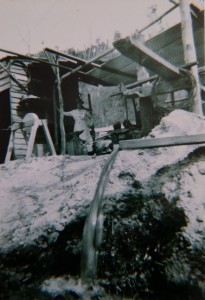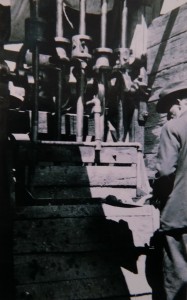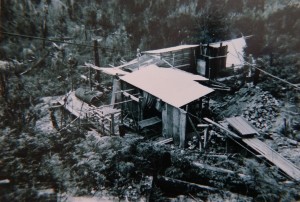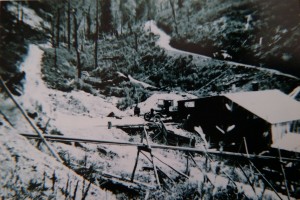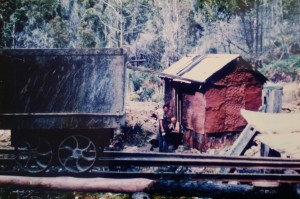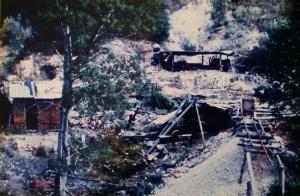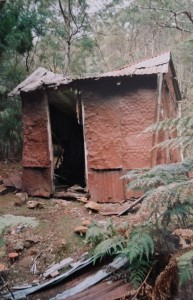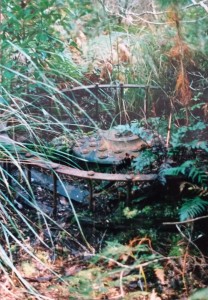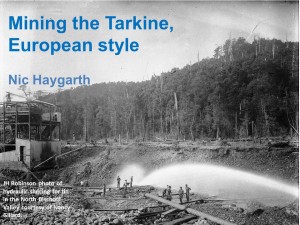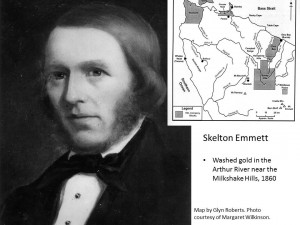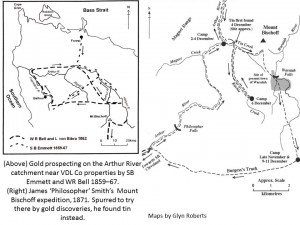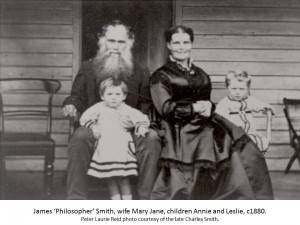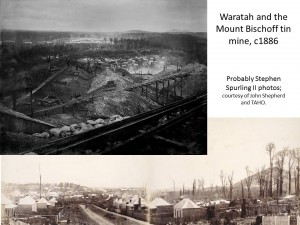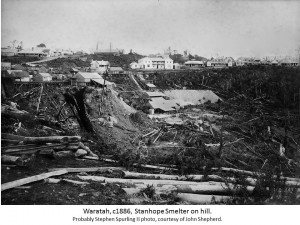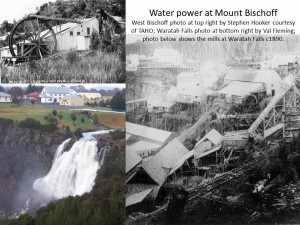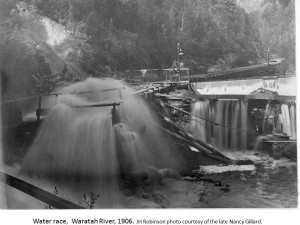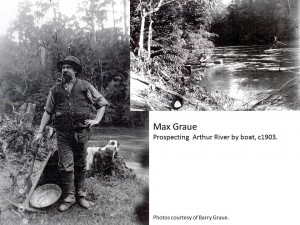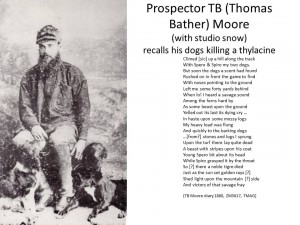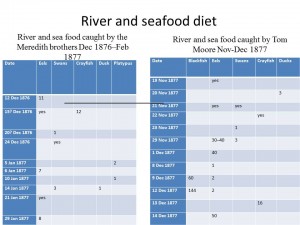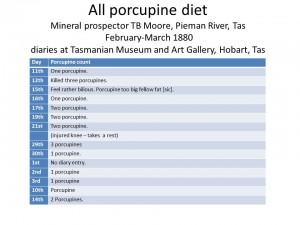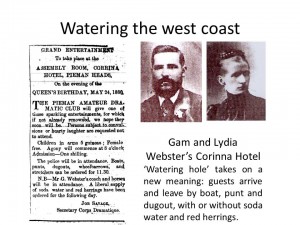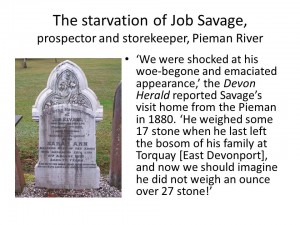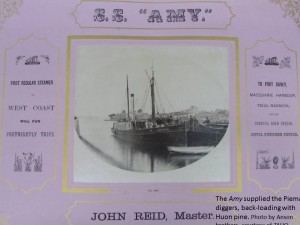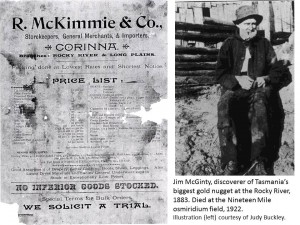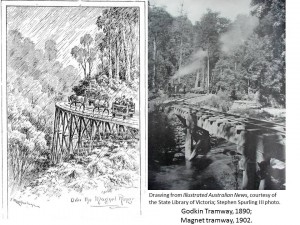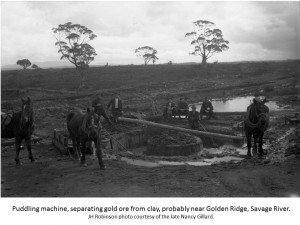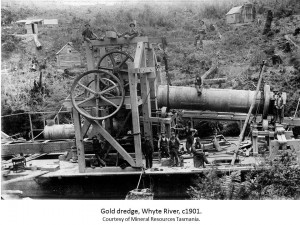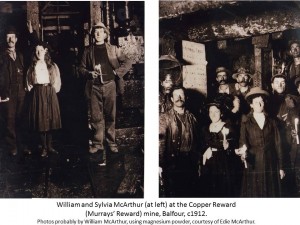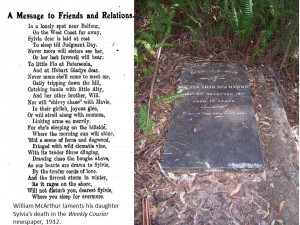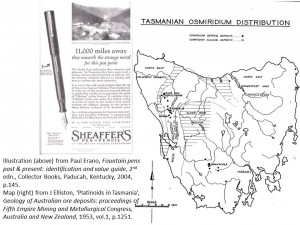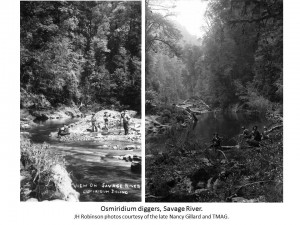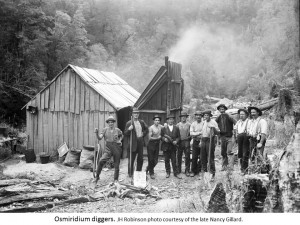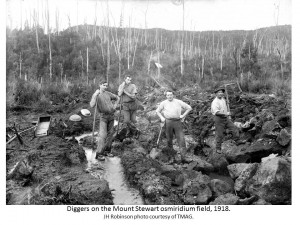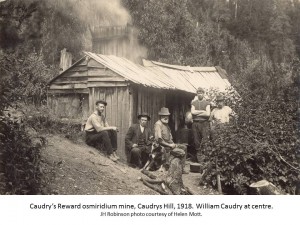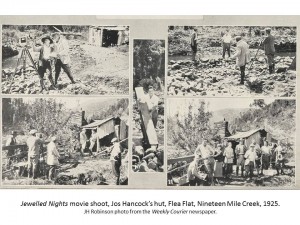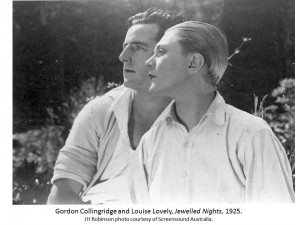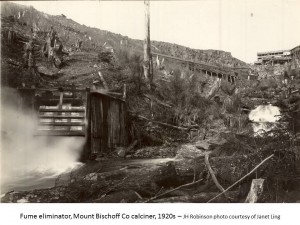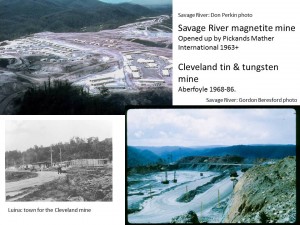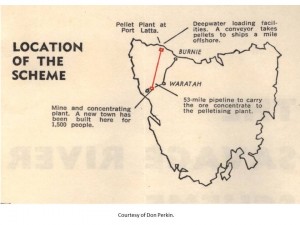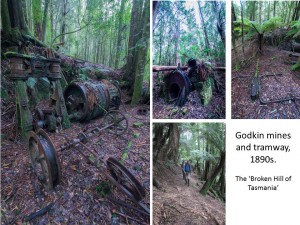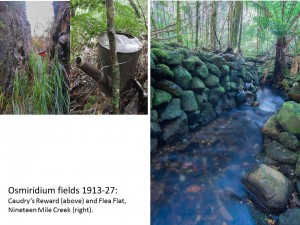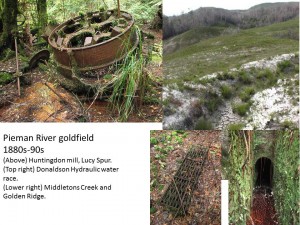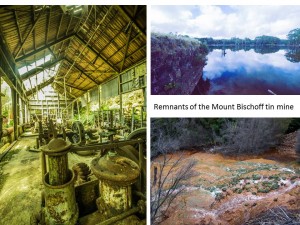Stanniferous drift is a term once used to describe tin-bearing ground, but it could just as easily describe the movement of tin mining families—or mining families of any other stripe—from one field to the next in search of better opportunities. Both economics and personal tragedy prompted depopulation of the small Middlesex mining field in north-western Tasmania around the time of World War I (1914–18). The contemporary photographs of bushwalker and national park promoter Ron Smith help tell the tale.
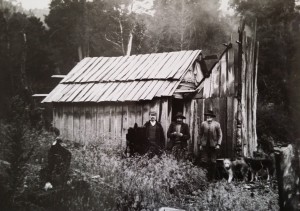
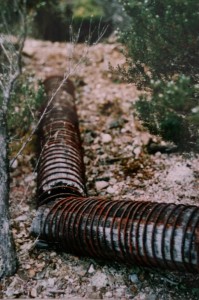
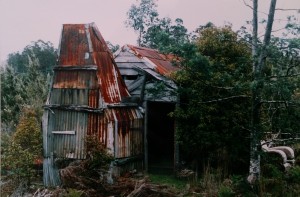
In Historic Tasmanian mountain huts, Simon Cubit and I told the story of the three Davis brothers, Clarence, Sidney (Sid) and Edmund (Eddie), who came to Tasmania from Victoria and tried to farm the Vale of Belvoir near Cradle Mountain in 1903.[1] When the farming venture failed, Clarence Davis returned home, but Boer War veteran Sid Davis (1879–1913) and Eddie Davis (1888–1944) stayed on in the Tasmanian highlands, taking up the lease of the Iris tin mine near Moina.
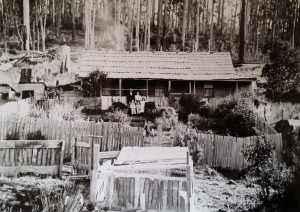
The Davis brothers’ partner in the mine was Charles Frederick Douglas Adam (c1864–1932).[2] Born in India as the son of an Anglo-Indian lieutenant, Adam had been sent home first to his parents’ house at Dover, England, to an aunt in France and to a Middlesex boarding school.[3] He is also said to have attended Eton, London and Cambridge Universities and the Sandhurst Academy—a busy schedule indeed, if it can be believed—before serving in the 81st Foot Regiment, with which he returned to India. Defective hearing prompted his retirement from the military, and he obeyed medical advice by settling in Australia. After a few years in Tasmania he arrived on the Bell Mount goldfield during the small rush there in 1892.[4] He made minor gold discoveries around the area at Golden Cliff and Stormont, and reworked the Bell goldfield when the hydraulic gold craze hit Tasmania. Charlie Adam married Charlotte Saltmarsh (1873–1946) in the nearby town of Sheffield in 1899.[5] They had children Charles William Guy Adam (1900), Mary Charlotte Adam (1902), Freda Kate Adam (1904), Frederick John Adam (1907), Robert Douglas Adam (1909) and Eileen.[6] There was also Charlotte’s daughter, Elsie (Elizabeth Mary Saltmarsh, born 1896), from a previous relationship.[7] Like many bush people, Charlie Adam used press subscriptions to keep up with the outside world, and his favourite was the weekly English illustrated newspaper The Graphic.[8]
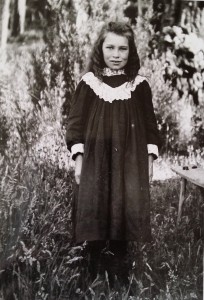
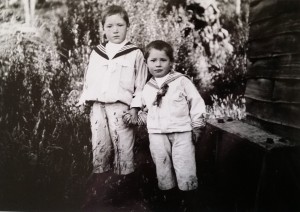
However, at a time when there was no school at nearby Moina, the Adams’ most important education supplement was the tutor they employed, Mary Smith, to teach their three eldest children.[9] One of the things Mary taught was propriety. The manager of the biggest mine in the district was William Hitchcock but, offended by his surname, Mary pronounced it ‘Hitchco’. Did her silent ‘ck’ remove the problem or draw attention to it?[10]
Sid Davis came to dinner at the Adam house at the Bell goldfield, met Mary the tutor and began to court her. They married and established a farm at Black Jack, the long straight on what is now the Cradle Mountain Road south of Moina. From here Sid had a short walk to his other work at the Iris tin mine. The couple’s first child, Gladys, did not survive, but they had a second daughter, Hilda, in 1911, and another, Molly, two years later.[11]
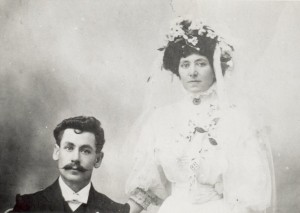
Mary found the isolation difficult. Young Harold Tuson of Lorinna, on the eastern side of the Forth River, found out how lonely she was. In contrast to Charlie Adam’s highly regimented upbringing, this thirteen-year-old had just entered the workforce on a road gang, building the Cradle Mountain Road, and was camped near the Davis house. While returning home for the weekend he ran into Sid Davis on the road:
I suppose he wanted someone to talk to … ‘Where did you come from? And what do you do?’, and … he said, ‘Call in’. Little two-room place on the left … ‘Call in and have a talk to the wife. She’s very, very lonely’. And so on the Monday I did [call in]. And I’m carrying a songbook and she and I got to work and were singing … and I decided I’d better go and she wouldn’t allow me, she didn’t want me to go. ‘Sing another song …’[12]
In 1912 Gustav and Kate Weindorfer established Waldheim Chalet, their tourist resort at Cradle Valley. Charlie Adam was one of their first guests, but Weindorfer also availed himself of the Davises’ hospitality when caught on the road in bad weather. On more than one occasion he rocked young Hilda Davis to sleep in her cradle.[13]
On 14 May 1913 Sid went to work as usual at 7 am. Two-year-old Hilda accompanied her father to the gate. The family’s dog, Bob, followed at Sid’s heels until Mary called him home. She was busy in the kitchen four hours later when she heard a horse galloping up to the house, followed by a knock at the door. It was her friend, a lady named Ward, a frequent visitor. Imagining that she had bad news to impart, Mary immediately thought of her mother. ‘Don’t tell me’, she cried, ‘go and tell Sid!’ ‘I can’t’, her visitor replied, ‘he’s dead’.[14]
Sid Davis had been working in the open cut when a tree stump fell on top of him, striking him fatally on the back of the head. He had survived guerrilla warfare in South Africa only to succumb in a mining trench in peacetime. ‘It was such a blow to Mum, really and truly’, Hilda Davis recalled,
She never got over it … She was always thinking of her days at the mine and of Dad. She never got it out of her system. She loved those days up there …[15]
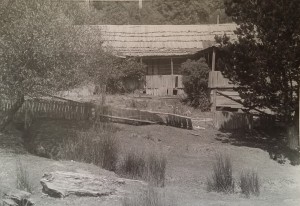
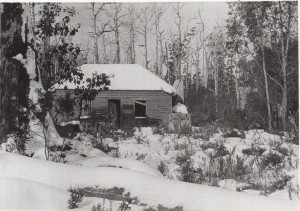
Mary Davis tried to keep the Iris mine going, but having a four-month-old child at her breast made it impossible. Tin mining was scuppered by World War I soon after. There was an exodus from the small mining field. Mary Davis tutored children in Sheffield, but eventually returned home to her parents. Eddie Davis married Moina postmistress Lil Gurr, with whom he adjourned to Melbourne.[16] Elsie Adam married miner Watty Davis at her parents’ house but set up home at the tungsten and tin village of Storeys Creek.[17] Charlie and Charlotte Adam moved to Waratah, but eventually resettled in another mining region, the Latrobe Valley, Victoria. Three other Adam children settled in mining towns.[18] By the mid-1920s both the Adam and Davis houses, where so many children had grown and so many lives had intersected, were ruins. Of the characters of this story, only Gustav Weindorfer, the widowed proprietor of Waldheim Chalet, remained trying to eke a living from the mountains.
[1] Simon Cubit and Nic Haygarth, Historic Tasmanian mountain huts, Forty South Publishing, Hobart, 2014, pp.18–23.
[2] Australian Death Index, registration 13455/1932.
[3] British Census, 1881, Middlesex, Finchley, District 1, p.54. His birthplace was given as India; ‘Mr Chas FD Adam, Yallourn, Vic’, Advocate, 8 February 1933, p.2.
[4] ‘Mr Chas FD Adam, Yallourn, Vic’, Advocate, 8 February 1933, p.2.
[5] Married 10 May 1899, marriage registration 962/1899, Sheffield.
[6] Birth registrations 2326/1900, 2391/1902, 2518/1904 respectively. Frederick John Adam’s death certificate (7866/1972, Victoria) give his year of birth as 1907. Robert Douglas Adam’s World War II military record gives his date of birth as 29 January 1909, place of birth Moina. Eileen Adam is mentioned as a surviving child in Charlie Adam’s obituary, Mr Chas FD Adam, Yallourn, Vic’, Advocate, 8 February 1933, p.2.
[7] Born 27 August 1896, birth registration 2328/1896, Sheffield.
[8] Interview with Harold Tuson, Canberra, 11 May 1995.
[9] Interview with Hilda Amos, née Davis, daughter of Sidney and Mary Davis, by Len Fisher, 21 September 1991. Harold Tuson, interviewed in Canberra, 11 May 1995, remembered Mary Smith as being the tutor for William and Kate Hitchcock at Moina.
[10] Interview with Harold Tuson, Canberra, 11 May 1995.
[11] Rose Ellen Gladys Davis was born 8 January 1910 and died 8 April 1910, birth registration 5417/1910, death registration 928/1910. Hilda May Davis was born 2 March 1911: Molly Davis was four months old at her father’s death: both facts from interview with Hilda Amos, née Davis, daughter of Sidney and Mary Davis, by Len Fisher, 21 September 1991.
[12] Interview with Harold Tuson, Canberra, 11 May 1995.
[13] Interview with Hilda Amos, née Davis, daughter of Sidney and Mary Davis, by Len Fisher, 21 September 1991.
[14] Interview with Hilda Amos, née Davis, daughter of Sidney and Mary Davis, by Len Fisher, 21 September 1991.
[15] Interview with Hilda Amos, née Davis, daughter of Sidney and Mary Davis, by Len Fisher, 21 September 1991.
[16] Interview with Hilda Amos, née Davis, daughter of Sidney and Mary Davis, by Len Fisher, 21 September 1991.
[17] See ‘Wedding bells’, Examiner, 12 April 1920, p.6.
[18] ‘Mr Chas FD Adam, Yallourn, Vic’, Advocate, 8 February 1933, p.2.
